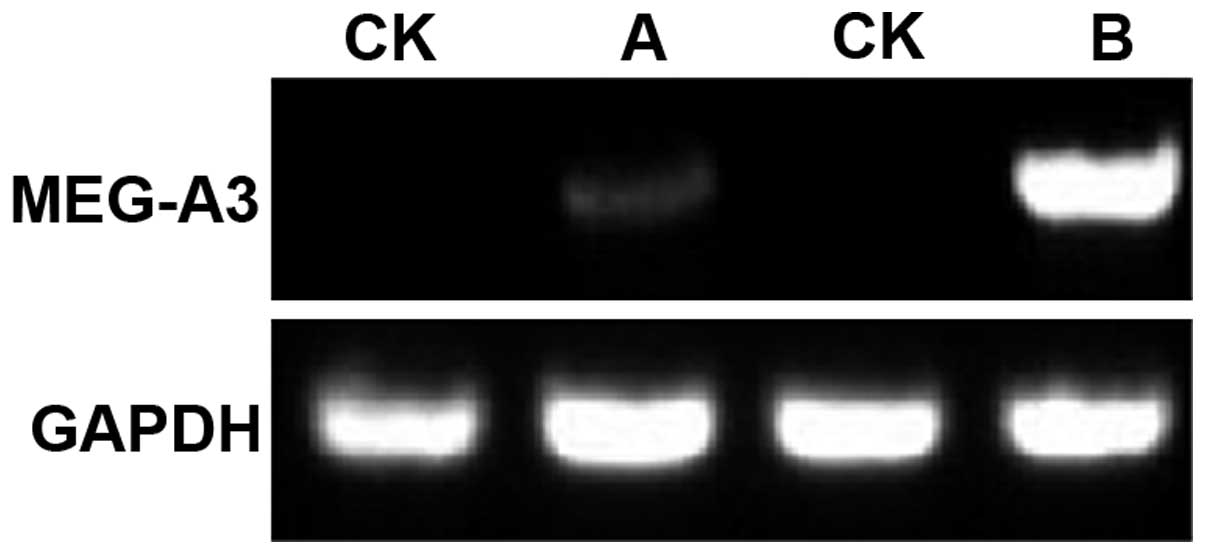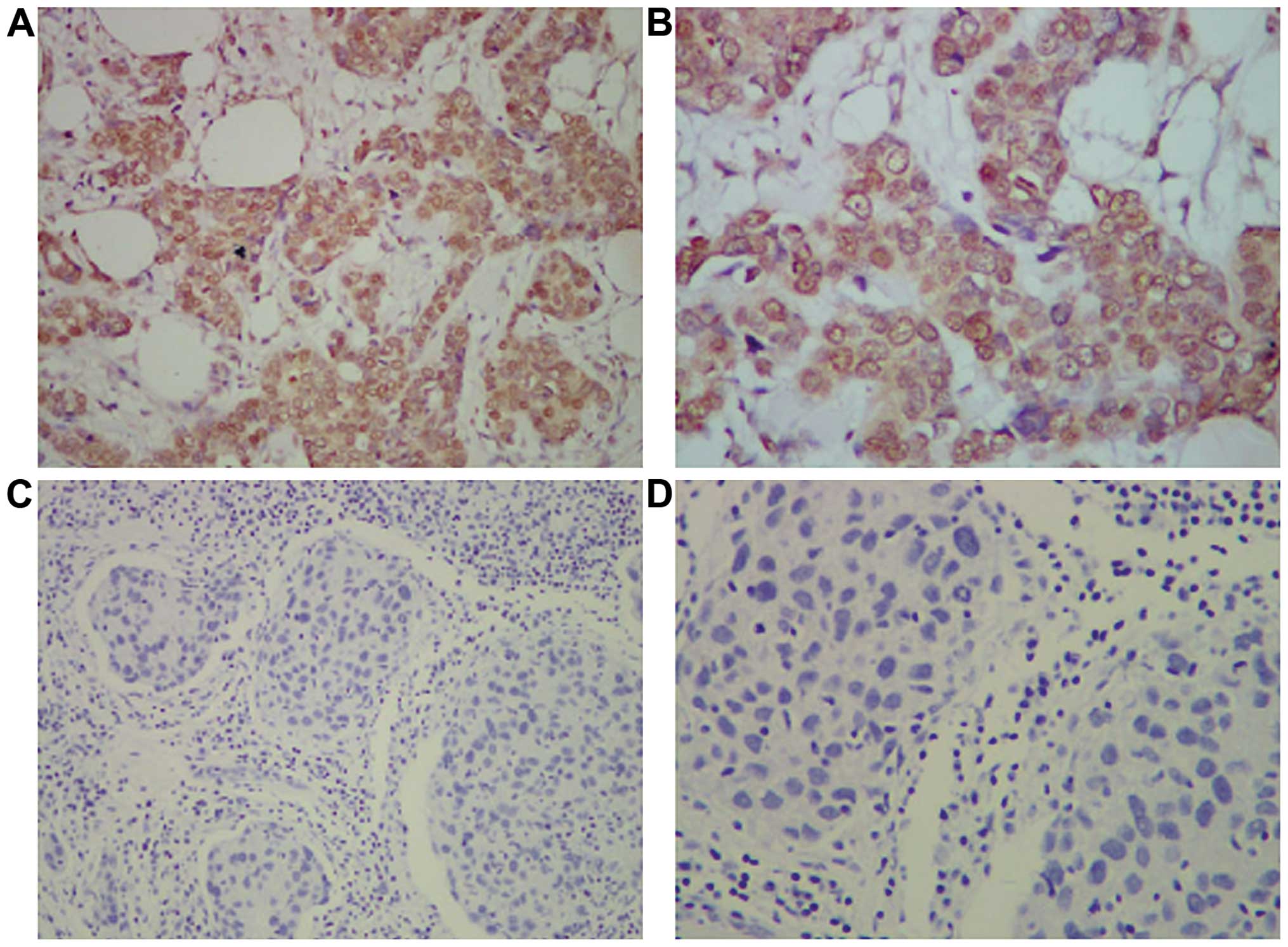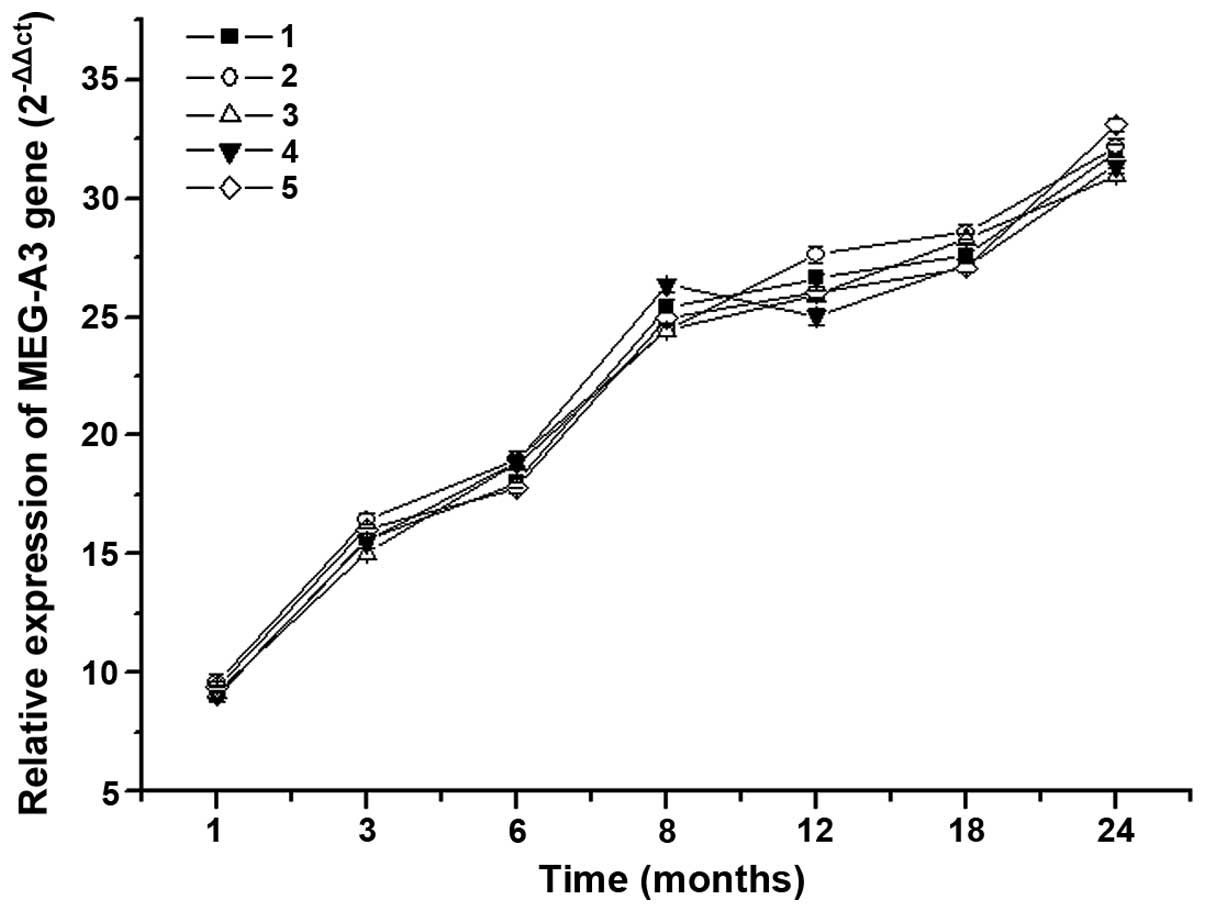Correlations between the MEG-A3 gene and incidence of breast cancer
- Authors:
- Published online on: October 27, 2016 https://doi.org/10.3892/ol.2016.5325
- Pages: 4925-4928
-
Copyright: © Hou et al. This is an open access article distributed under the terms of Creative Commons Attribution License.
Abstract
Introduction
According to statistics of the International Union of Counter Cancer, breast cancer has a relatively high morbidity (1). It accounts for almost 28.5% of the total number of female cancers. Approximately 1,600,000 women suffer from breast cancer each year, of whom 780,000 women succumbed to breast cancer (1). The mortality rate is at approximately 48.76%, with an annual increase of 0.42–6.5% (1). The proportion of women with breast cancer in China is also on the increase, accounting for 36.5% of female malignant tumors. The incidence of the disease is 26.4% among women, with a mortality rate of 49.2%, which is slightly higher than global rates (2). Thus, the diagnosis and treatment of breast cancer is crucial.
Melanoma antigen gene (MAGE) is affiliated to cancer and the testis antigen family. A high expression of MAGE gene can be detected in many tumors and malignant tissues (3–5). Approximately 60 different types of MAGE genes have been identified. According to its expression patterns and differences in gene structure, MAGE can be divided into the subcategories, MAGE-1 and MAGE-2 (6).
In the present study, we first identified genes associated with morbidity of breast cancer that contain the specific conserved domain of the MAGE gene family (7). The interrelation between MAGE gene and breast cancer was preliminarily investigated. In addition, we conducted a preliminary discussion on the interrelation between them to provide some theoretical guidance for the later treatment of breast cancer.
Patients and methods
Patient samples
The clinical samples used in the present study were all from surgical specimens of patients with breast cancer admitted to the Henan Province People's Hospital between June 2012 and April 2014. The patients were aged between 25 and 56 years, and the average age was 45–23.4 years. Normal women were aged 26–58 years, and the average age was 43.3–23.9 years. The study patients were randomly divided into the control and observation groups. The control group included 27 normal women, and the observation group included 27 women with breast cancer.
Experimental drugs
The breast cancer detection kit used in this study was purchased from Roche Diagnostics (Basel, Switzerland). Other relevant drugs were purchased from Thermo Fisher Scientific (Waltham, MA, USA). Relevant fluorescence quantitative primers were produced by Takara Bio (Dalian, China). Primary mouse monoclonal MEG-A3 antibody was provided by PeproTech (Rocky Hill, NJ, USA; cat. no. 60054-1; dilution, 1:500). Peroxidase-conjugated secondary polyclonal goat-anti-mouse antibody (1:1,000) was purchased from Santa Cruz Biotechnology, Inc. (Santa Cruz, CA, USA; cat. no. sc-395763).
RNA cell extraction of breast cancer
Tissue (0.1 g) was dispensed in 0.45 ml of RNA Plus and homogenized in the precooling mortar. Subsequently, the contents were transferred to the 1.5-ml EP tube and 0.45 ml of RNAPlus was added. Chloroform (200 µl) was added to the tube, followed by centrifugation at 10,000 × g, at 4°C for 15 min. The supernatant was transferred into the EP tube containing dimethyl carbinol and the contents were homogenized on ice for 10 min. The solution was centrifuged at 12,000 rpm, at 4°C for 10 min, and then 750 µl of 75% ethanol was added. The tube contents were centrifuged at 12,000 rpm, 4°C for 10 min. The supernatant was discarded and RNase-free water was added to resuspend the pellet. The extracted RNA was quantified for purity and concentration with a UV-visible spectrophotometer (BioSharp, Hefei, China).
Fluorescence quantitative polymerase chain reaction (PCR)
The procedure was conducted according to the protocol of the kit (Takara fluorescence quantitative PCR specification).
Detection of MEG-A3 expression in serum by enzyme-linked immunosorbent assay (ELISA)
The procedure was conducted according to the specification of the ELISA kit (8). The standards were diluted according to the proportion of 1:25 with assay buffer, and the standard curve was designed. The sample to be tested was first diluted at a 1:100 ratio and then TMB chromogenic substrate was added to each well. After incubation for 2 h at 20°C, the absorbance was determined at 495 nm using a microplate reader (BioTek Instruments, Inc., Winooski, VT, USA). The content and concentration of MEG-A3 in each sample were calculated according to the standard curve.
Detection of MEG-A3 in breast cancer tissue by immunohistochemistry
The control and test samples were incubated using streptavidin-peroxidase (SP) as previously described (8). The criteria for the evaluation of the immune system were as follows (9): If capsule staining was <10% or tumor cells exhibited a negative reaction after staining, it was determined as negative. If only the cell membrane was stained or capsule staining showed >10% content of tumor cells, it was determined as positive. Over 10% of tumor cells showing a weak or medium complete stain was considered as strongly positive (++), whereas >10% of tumor cells showing strong complete membrane staining was determined as strongly positive (++).
Detection of MEG-A3 in breast cancer tissue and serum with western blotting
A Roche animal cell protein extraction kit was used to extract the total protein of samples (10). Western blotting was carried out as previously described (10).
Statistical analysis
SPSS 20.0 statistical software (Chicago, IL, USA) was used for data analysis. The correlative measurement results were indicated as mean ± SD. P<0.05 was considered statistically significant.
Results
MEG-A3 mRNA expression level of normal patients and patients with breast cancer
The expression of MEG-A3 mRNA in patients with breast cancer was higher than that in controls, and the expression level was different in patients with a different course of disease (Fig. 1). Comparison of the MEG-A3 mRNA levels for normal and observation group showed that the average expression level of MEG-A3 gene in patients with breast cancer was 6- to 7-fold significantly higher than that for controls (p<0.05). Thus, there is a certain correlation between MEG-A3 gene and breast cancer.
Expression of MEG-A3 in serum of patients with breast cancer and controls
The ELISA results showed that the average expression of MEG-A3 in serum of healthy women was ~7.14–5.76 ng/ml. The results of MEG-A3 in serum of 27 female patients with breast cancer showed that its average level of MEG-A3 in serum was 12.47–10.17 ng/ml. It indicated that levels in serum of female patients with breast cancer was significantly higher than those in normal controls (Table I).
Immunohistochemistry
The immunohistochemical staining of breast cancer tissues for MEG-A3 revealed that the positive staining of MEG-A3 expression was mainly concentrated in the breast cancer cell membrane (A/B) (Fig. 2). The main feature was yellow brown small particles of non-uniform sizes, which was not identified in the breast tissue of normal women.
MEG-A3 mRNA expression level of patients with different stage of breast cancer
The result of MEG-A3 mRNA expression levels of patients with different stages of breast cancer is shown in Fig. 3. The data analysis showed that MEG-A3 mRNA expression levels of patients was increased with the prolongation of the disease. The increase had a downward-ascend-downward trend, especially between 8 and 18 months of disease. The mRNA expression level was significantly increased, which indicated that there was an interrelation between MEG-A3 gene and breast cancer. Thus, there is a positive correlation between the level of MEG-A3 gene expression and the severity of breast cancer patients.
MEG-A3 expression level of patients with different stage of breast cancer
MEG-A3 protein expression was detected in the patients with breast cancer at different time points using western blotting (Fig. 4). It was identified that MEG-A3 protein expression level in the serum of patients increased with the prolongation of the disease, and the increments increased apparently since six months after diagnosis with disease. Thus, there was a positive correlation between the level of MEG-A3 in serum and the severity of breast cancer patients.
Correlation between MEG-A3 expression level in tissue and serum of patients with breast cancer
The detection result of MEG-A3 expression level in the tissue of 27 patients with breast cancer showed that the level was 24.62–9.24 ng/ml. The MEG-A3 content in tissue of normal women was 11.7–5.22 ng/ml, and significant differences were detected (P<0.05). The detection of MEG-A3 expression level in serum of 27 patients with breast cancer showed that the level was 12.47–10.17 ng/ml. The MEG-A3 content in tissue of normal women was 7.14–5.76 ng/ml, and significant differences were observed (P<0.05). There was a positive correlation between the content of MEG-A3 in tissue and serum (r=0.401). The serological detection method was consistent with the histological detection method (κ consistency check κ=0.392).
Discussion
MAGE is a cancer/testis antigen family member that has no or little expression in other tissues except testis and placenta (11,7). However, MEGA gene can be detected in some tumor and cancer cells. It is believed that MEGA protein can be used for the detection and treatment of certain tumors (12,13). MAGE gene has different degrees of expression in melanoma, lung, breast, liver, and ovarian cancer, as well as other diseases (14–18). Additionally, in the same type of tumor disease, there were many different subtypes of MAGE genes involved. In recent years, as the proportion of female breast cancer has been on the increase (19), the rapid diagnosis of breast cancer has become a research hot spot. The genes associated with breast cancer morbidity and deterioration can be divided into two categories, the one associated with breast cancer at the mRNA level and the other associated with breast cancer at the protein level (20,21). The experiment of Canzian et al identified 61 genes that may be associated with breast cancer (22). However, no detailed study is available on the mechanism of mRNA and its protein level.
In the current study, we found that the conserved domains were commonly used as epitopes of MAGE and protein interaction sites by nucleotide and amino acid sequences. Therefore, the MEG-A3 gene may be partially associated with morbidity of tumors and cancers. We confirmed that there was a certain correlation between MEG-A3 gene and breast cancer through the study, the results of which indicated that the expression of MEG-A3 was higher in the serum and breast tissues of patients with breast cancer and was significantly different compared to normal women. However, the molecular mechanism for MEG-A3 in patients with breast cancer remains to be elucidated.
In conclusion, to the best of our knowledge, in the present study for the first time, we identified the association of a new gene known as MEG-A3 with breast cancer in women. Using sequence alignment we found that, it has similar conserved domains with MAGE. By comparing the expression of MEG-A3 gene in normal women and women with breast cancer, we found that the MEG-A3 gene mRNA and protein levels were significantly increased in the patients (P<0.05). Further research revealed that there was a positive correlation between the levels of MEG-A3 in serum and the course of disease for breast cancer patients. The levels of MEG-A3 gene in serum of patients was enhanced with the prolongation of the disease. By comparing the expression level of MEG-A3 in serum and breast tissue, it was identified that the method of serum detection and histological examination has a good consistency for MEG-A3. Thus, there was a positive correlation between MEG-A3 gene and breast cancer, which can be used for the detection of breast cancer and relevant treatment to a certain extent. Additionally, the findings provided a theory and experimental basis for the later treatment of breast cancer.
References
|
Peng W: Clinical observation of 86 cases of early breast cancer conserving surgery. Contemporary Medicine. 1:107–108. 2012. | |
|
Jia ZC, Tian Y, Huang ZM, Wang JX, Fu XL, Ni B and Wu YZ: Identification of a new MAGE-A10 antigenic peptide presented by HLA-A*0201 on tumor cells. Cancer Biol Ther. 11:395–400. 2011. View Article : Google Scholar : PubMed/NCBI | |
|
Otte M, Zafrakas M, Riethdorf L, Pichlmeier U, Löning T, Jänicke F and Pantel K: MAGE-A gene expression pattern in primary breast cancer. Cancer Res. 61:6682–6687. 2001.PubMed/NCBI | |
|
Toso JF, Oei C, Oshidari F, Tartaglia J, Paoletti E, Lyerly HK, Talib S and Weinhold KJ: MAGE-1-specific precursor cytotoxic T-lymphocytes present among tumor-infiltrating lymphocytes from a patient with breast cancer: characterization and antigen-specific activation. Cancer Res. 56:16–20. 1996.PubMed/NCBI | |
|
Wolff AC, Hammond ME, Schwartz JN, Hagerty KL, Allred DC, Cote RJ, Dowsett M, Fitzgibbons PL, Hanna WM, Langer A, et al: American Society of Clinical Oncology/College of American Pathologists: American Society of Clinical Oncology/College of American Pathologists guideline recommendations for human epidermal growth factor receptor 2 testing in breast cancer. Arch Pathol Lab Med. 131:18–43. 2007.PubMed/NCBI | |
|
Goodyear O, Agathanggelou A, Novitzky-Basso I, Siddique S, McSkeane T, Ryan G, Vyas P, Cavenagh J, Stankovic T, Moss P, et al: Induction of a CD8+ T-cell response to the MAGE cancer testis antigen by combined treatment with azacitidine and sodium valproate in patients with acute myeloid leukemia and myelodysplasia. Blood. 116:1908–1918. 2010. View Article : Google Scholar : PubMed/NCBI | |
|
Lian Y, Sang M, Ding C, Zhou X, Fan X, Xu Y, Lü W and Shan B: Expressions of MAGE-A10 and MAGE-A11 in breast cancers and their prognostic significance: A retrospective clinical study. J Cancer Res Clin Oncol. 138:519–527. 2012. View Article : Google Scholar : PubMed/NCBI | |
|
Riener MO, Wild PJ, Soll C, Knuth A, Jin B, Jungbluth A, Hellerbrand C, Clavien PA, Moch H and Jochum W: Frequent expression of the novel cancer testis antigen MAGE-C2/CT-10 in hepatocellular carcinoma. Int J Cancer. 124:352–357. 2009. View Article : Google Scholar : PubMed/NCBI | |
|
Perez D, Hauswirth F, Jäger D, Metzger U, Samartzis EP, Went P and Jungbluth A: Protein expression of cancer testis antigens predicts tumor recurrence and treatment response to imatinib in gastrointestinal stromal tumors. Int J Cancer. 128:2947–2952. 2011. View Article : Google Scholar : PubMed/NCBI | |
|
Mei-Xing S, Bao-En S, Cui-Zhi G and Wei G: Effect of melanoma antigen MAGE-A4 on the transcriptional activity of p53. Tumors. 29:428–432. 2009. | |
|
Montoro JR, Mamede RC, Serafini L Neder, Saggioro FP, Figueiredo DL, Silva WA Jr, Jungbluth AA, Spagnoli GC and Zago MA: Expression of cancer-testis antigens MAGE-A4 and MAGE-C1 in oral squamous cell carcinoma. Head Neck. 34:1123–1128. 2012. View Article : Google Scholar : PubMed/NCBI | |
|
Sang M, Lian Y, Zhou X and Shan B: MAGE-A family: Attractive targets for cancer immunotherapy. Vaccine. 29:8496–8500. 2011. View Article : Google Scholar : PubMed/NCBI | |
|
Sang M, Wang L, Ding C, Zhou X, Wang B, Wang L, Lian Y and Shan B: Melanoma-associated antigen genes - an update. Cancer Lett. 302:85–90. 2011. View Article : Google Scholar : PubMed/NCBI | |
|
Ming M and Lizhang Y: The expression and significance of tumor specific antigen MAGE gene. Foreign Medical Sciences of Urinary System. 23:526–529. 2003. | |
|
Wu QR: Risks for breast cancer in chinese female: a systematic review. Mod Prev Med. 38:61–72. 2011.(In Chinese). | |
|
Osterlund C, Töhönen V, Forslund KO and Nordqvist K: Mage-b4, a novel melanoma antigen (MAGE) gene specifically expressed during germ cell differentiation. Cancer Res. 60:1054–1061. 2000.PubMed/NCBI | |
|
Suzuki S, Sasajima K, Sato Y, Watanabe H, Matsutani T, Iida S, Hosone M, Tsukui T, Maeda S, Shimizu K, et al: MAGE-A protein and MAGE-A10 gene expressions in liver metastasis in patients with stomach cancer. Br J Cancer. 99:350–356. 2008. View Article : Google Scholar : PubMed/NCBI | |
|
Zhang S, Zhou X, Yu H and Yu Y: Expression of tumor-specific antigen MAGE, GAGE and BAGE in ovarian cancer tissues and cell lines. BMC Cancer. 10:1632010. View Article : Google Scholar : PubMed/NCBI | |
|
Yang L, Li LD, Chen YD and Parkin DM: Time trends, estimates and projects for breast cancer incidence and mortality in China. Chin J Oncol. 28:438–440. 2006.(In Chinese). | |
|
Schrauder MG, Fasching PA, Häberle L, Lux MP, Rauh C, Hein A, Bayer CM, Heusinger K, Hartmann A, Strehl JD, et al: Diabetes and prognosis in a breast cancer cohort. J Cancer Res Clin Oncol. 137:975–983. 2011. View Article : Google Scholar : PubMed/NCBI | |
|
Yu Z, Liu Z and Yu K: The clinical features and prognosis of patients with type 2 diabetes in breast cancer patients. China. J Cancer. 6:466–470. 2010.(In Chinese). | |
|
Canzian F, Cox DG, Setiawan VW, Stram DO, Ziegler RG, Dossus L, Beckmann L, Blanché H, Barricarte A, Berg CD, et al: Comprehensive analysis of common genetic variation in 61 genes related to steroid hormone and insulin-like growth factor-I metabolism and breast cancer risk in the NCI breast and prostate cancer cohort consortium. Hum Mol Genet. 19:3873–3884. 2010. View Article : Google Scholar : PubMed/NCBI |













